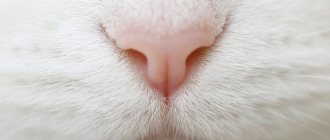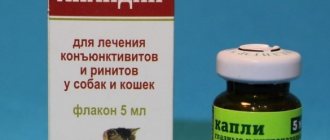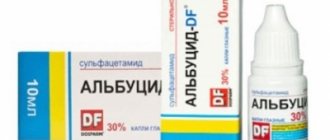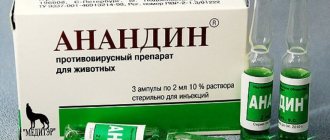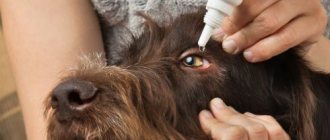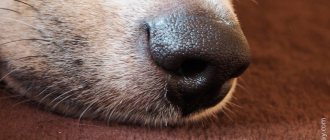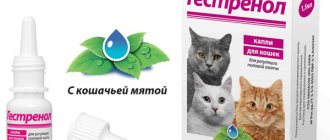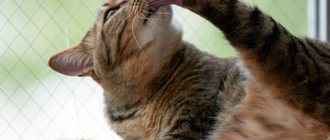6237Pavel
Representatives of the cat family are daily exposed to an increased risk of damage to the mucous membrane of the visual organs, and during play they can become infected with various types of infections, which cause severe irritation. For this reason, it is recommended to regularly instill various medications that can provide protection. But not everyone knows how to put drops in a cat’s eyes, but the effectiveness of the drops depends on knowledge of this procedure. Proper instillation can quickly eliminate irritation and speed up the recovery process.
Types of drops for the treatment of eye diseases
Eye diseases in representatives of the cat family are quite common.
Inflammation that appears, at first glance insignificant, without proper and timely treatment can lead to partial or complete loss of vision. Therefore, if your cat’s eye is leaking, or there is redness or swelling, you should immediately go to the vet. He will prescribe suitable eye drops. The ability to understand eye diseases on your own will also be helpful. It should be noted that eye diseases in cats can be accompanied by the following symptoms:
- Discharge of bloody fluid, blood from the eye. As a rule, this occurs with mechanical trauma. Perhaps the cat was scratched with its claws or came across a hairpin or wire. Only a veterinarian can determine the depth and area of damage. Therefore, it is recommended to visit a veterinary clinic as soon as possible. Sometimes, a special healing agent will be enough. But in severe cases, microsurgery may be required.
- Purulent and mucous discharge from the eyes of cats is observed when bacteria develop in the conjunctival sac. There are many reasons for the penetration of microorganisms into the visual organ of an animal: previous cold infections with weakened immunity, mechanical damage to the eye.
- Swelling of the eyelids can develop as a result of a general or local allergy to medications, chemicals, products, etc.
- The presence of a film on the eyes is a fairly common phenomenon. If your cat's eyes are half covered with a blue or white film, inflammation is likely occurring. In addition, pus may be released and the eyelids may swell. A similar picture occurs as a result of injury and a viral infection entering the visual organ. It is important to relieve inflammation. Therefore, treatment of cat eyesores is carried out by washing the eyes with Metrogyl or special cat drops. But it is important to know that perhaps the cause of the appearance of a cataract is the development of conjunctivitis or cataracts. Such diseases are also characterized by clouding of the cornea. Therefore, it is important to contact an experienced veterinarian.
- But a completely cloudy eye in a cat can be a sign of a serious pathology. For example, intoxication of the body, chemical poisoning, inflammation of the cornea, optic nerve atrophy, glaucoma, etc. To avoid dangerous consequences, you should immediately contact a veterinary clinic.
- If a cat's eye is red, the cause is inflammation. The visual organ turns red due to a viral disease, rhinotracheitis, conjunctivitis, or mechanical damage. It can also be a symptom of diseases such as mycoplasmosis and chlamydia. Vascular keratitis is also possible, in which blood vessels grow onto the surface of the anterior chamber of the eye.
- The accumulation of fluid in the corners of a cat’s eyes is a clear sign of pathology. Intense lacrimation indicates the development of the disease. This could be conjunctivitis, allergies, bacterial, fungal or viral infections.
For damage to the visual organs in cats, veterinary practice usually prescribes one of the five most common medications. All these drops are easily tolerated by pets and almost never cause side effects.
Levomitin for cats
However, you should not carry out drop therapy for eye inflammation on your own, without prior consultation with a veterinarian:
- Levomycetin. An antibiotic with a wide spectrum of action. It has a pronounced therapeutic effect, destroying the causative agent of inflammation. The drug is prescribed for conjunctivitis, blepharitis, keratitis, to prevent complications after surgery and for eyeball injury accompanied by infection.
- Anandin. An effective healing and anti-inflammatory agent. The active ingredient in the drug is glucaminopropylcarbacridone. Use the remedy for conjunctivitis in the morning and evening. Anandin is instilled under the lower eyelid so that the product is evenly distributed over the cornea. Treatment period is up to 14 days.
- Tsiprovet. An antibacterial drug that also relieves inflammatory processes. The main effect of the medicine is to destroy the bacteria that caused the inflammatory process. The composition is used to treat inflammation of the organs of vision, as well as to prevent complications after surgery and in preparation for it.
- Leopard. Antibacterial drops that destroy not only bacterial pathogens, but also viral ones, as well as Pseudomonas aeruginosa. The medicine is also effective against some parasitic microorganisms that can infect the eyes of cats. Prescribed for the treatment of inflammatory diseases and infected injuries.
- Iris. An antimicrobial agent whose active ingredient is gentamicin. Used in the treatment of conjunctivitis, keratitis, uveitis, blepharitis, ulcers, and corneal erosions.
Be sure to read:
Dexafort® instructions for use in veterinary medicine for cats
It is advisable to select any eye drops for cats with a veterinarian. When this is not possible, they use broad-spectrum compounds that are active against bacteria, viruses, and protozoa. This is the only way the effect of treatment will be positive.
The prescriptions for the use of various eye drops in cats are similar, so it is possible to generalize the recommendations for their use.
Anandin for cats
The medicine is prescribed in this form in the following cases:
- infected injuries of the organs of vision (in complex treatment);
- preparing a cat for ophthalmic surgery;
- prevention of complications after eye surgery;
- conjunctivitis of various natures and forms;
- keratitis;
- blepharitis;
- inflammatory processes in the nasolacrimal ducts.
We suggest you read: How to comb a cat's mats
The manifestations of many eye pathologies in cats are similar, which is why trying to self-medicate is quite dangerous. In case of severe lesions, drops are used only in complex therapy in parallel with antibiotic injections.
The main eye pathologies in cats are:
- Conjunctivitis - when the disease occurs, inflammation of the mucous membrane of the eyelids occurs. The reasons for the development of the disease are varied - from dirt getting into the eye to infection.
- Keratitis is an inflammation of the cornea in cats that usually also affects the eyelids.
- Blepharitis is an inflammation of the eyelids, which may be accompanied by the formation of ulcers.
- Cataracts are similar to this disease in humans and are treated with surgery.
Other pathologies of the visual organs in cats are rarely observed. Injuries to the eyeball more often occur in pets that have free access to the street.
Cats often suffer from eye diseases. Based on the type of illness and the reasons for its occurrence, drops are prescribed:
- antiseptic;
- with an antibiotic;
- antiviral.
Antiseptic
Drops from this group are used for purulent processes caused by fungi or bacteria. The presence of an antiseptic helps to disinfect the affected area of the eye and restore the natural level of physiological balance of eye fluids. Such drops include Lakrikan or Ophthalmosan.
Lakrikan is a drug for the treatment and prevention of conjunctivitis and blepharitis
Antibacterial
Such preparations contain an antibiotic that effectively fights infections and prevents the growth and reproduction of bacteria. The drops contain substances of semi-synthetic and natural origin intended to destroy pathogens. Veterinarians usually recommend drops of Tsiprovet, Iris, Dekta-2, Lacrimin-aseptic.
Antibacterial drops are used for traumatic injuries of the eyeball and eye infectious diseases
Antiviral
Drugs from this group contain interferon. This substance helps the body fight the disease itself. Such drops will help reduce the likelihood of relapse of the disease and the development of complications, as well as speed up recovery. Usually the product is prescribed together with drops from the antibacterial group. Veterinarians often prescribe Maksidin and Anadin.
Maxidin - intranasal and eye drops for the treatment of non-infectious, infectious and allergic diseases
There are other types of eye drops for cats:
- moisturizing - necessary to eliminate dryness and redness of the cornea, for example, Bars drops;
- antihistamines - will help get rid of allergies, relieve itching, redness and swelling, for example, Desacid;
- preventive - used to prevent the occurrence of eye diseases: Diamond Eyes, Dekasept or SaniPet lotion.
Drops Diamond eyes have bactericidal, anti-inflammatory and anti-edematous properties
For the treatment of conjunctivitis in a cat, I chose Ciprovet, and for preventive purposes, Diamond Eyes.
Rules for using eye drops:
- Remember that before each drop it is necessary to treat the eye area so as not to spread the infection and remove accumulated pus and discharge. To do this, you can use a cotton pad moistened with boiled water. The eye should be wiped from the outer corner to the inner.
- After cleaning, you need to carefully move the lower eyelid and drip the medicine (the number of drops is determined by the instructions).
- The cat should not be released immediately so that the pet does not scratch its eye.
- After the procedure, you can calm your pet and treat him with a treat.
After an unpleasant procedure, you can treat your cat with a treat
My Persian cat suffers from eye problems. Nature has a non-standard arrangement of the lacrimal glands, so he has constant lacrimation, and this is a favorable environment for the growth of bacteria. Accordingly, I have to constantly treat my eyes, and yet I still do not always have time to prevent the disease.
When this problem returns, I brew chamomile and wait until the liquid cools. Then I put a sponge, eye drops, and a decoction next to me. I put the cat in my arms and carefully wipe away all the discharge around the eyes with a sponge soaked in a herbal infusion. Then I move the eyelid from below and drop one drop of medicine. I don’t let go of him right away, because he’ll try to itch, and that’s not allowed. After a couple of minutes I let him go.
Indications for use
Eye drops for cats are used when the animal has:
- injury to the eye and tissues directly adjacent to the eyeball;
- inflammatory processes occurring on the mucous membrane and affecting the eye;
- swelling of various natures.
Eye drops for cats
Important! Cat owners should remember that eye drops can be used only after visiting a veterinarian, examining the animal and prescribing a certain drug. This is due to the fact that each type of disease requires a specific version of drugs that have a narrow direction of action on the animal’s body.
So we can highlight veterinary eye drops for cats, which have the following effects:
- antiseptic;
- moisturizing;
- increasing metabolic rate;
- antihistamine;
- medicinal;
- preventive.
Healthy cat eyes
Antiviral drops can copy the symptoms of various infectious or bacterial viral diseases that have different etiologies or genesis.
Note! Drops that have an antiviral effect can be presented in the form of substances that have biological activity. This is a group of interferons or interferon inducers, as well as drugs created on their basis.
Antibacterial
The active substances included in antibacterial drops effectively fight various diseases that are caused by bacteria, for example, conjunctivitis, when a cat’s eyes begin to fester and yellow and brown crusts appear on them, and eyelash loss may also occur.
Antiseptic
Antiseptic drugs can relieve inflammation, which can be caused by bacterial infections.
Inflammatory processes of the eyes in cats and their signs
Cat owners can easily detect eye disease in their pet - each disease has its own symptoms, but there are common signs that indicate the presence of problems:
- the upper or lower eyelid takes on an uncharacteristic shade;
- swelling appears;
- the cat squints, blinks a lot, tears flow;
- discharge of pus or mucus;
- the shade and size of the cornea or pupil change.
The most common eye diseases in cats:
- conjunctivitis is an inflammation of the mucous membrane, veterinarians distinguish three types of the disease: catarrhal - occurs due to injuries to the eyelids or a foreign body that has entered the eye, in this case the animal begins to have profuse lacrimation, the eyelids look swollen;
- follicular - there is an increase in the lymph nodes of the third eyelid, the disease progresses when the cat is in unsanitary conditions;
- purulent - the infection affects the mucous membrane of the eyelids and eyes, swelling and discharge of pus are visually noted.
- ulcerative;
We suggest you read: Cat or cat how to determine gender
How to instill eye drops into a cat?
Putting drops into a child’s eyes is a responsible undertaking that needs to be approached correctly. If children of school age and older understand the importance of the event and are much calmer about it. It is very difficult for the baby to carry out the procedure if he does not sit in one position.
So, the stages of the procedure:
- The most important thing is to calm the child down. He needs to explain that it won’t hurt. If the baby does not sit quietly, the therapeutic effect will be poor, and in many cases, there will be no effect at all.
- We wash our hands with soap, preferably antibacterial. Wipe dry.
- If the drug is in your home medicine cabinet, check the expiration date. When storing the medicine in the refrigerator, you should take it out in advance so that it warms up a little at room temperature.
- The child should be placed on a horizontal surface without a pillow or seated in a chair with his head thrown back.
- With one hand we push back the lower eyelid to create space for instilling the drug. With the other hand we hold the bottle upside down above the eye.
- Squeeze 1-2 drops from the bottle and press the lower eyelid. At this moment, the child should not spin, stand up or cry.
- Hold for 1-2 minutes. You can lightly massage the inner corner of the eye.
- Then we repeat the procedure with the other eye.
- Wipe off excess drops with a clean handkerchief.
If the child strongly resists and does not allow the procedure to be completed, then you can ask someone to hold the child. Just under no circumstances should you intimidate the baby or use physical force. Everything should happen in a playful way.
To administer drops to a baby, you also do not need to have any special skills. In many cases, babies under one year of age tolerate the procedure more calmly than older children.
The baby should be placed on a flat surface. Prepare the drug and pipette in advance. To make the baby lie calmer, he can be distracted. Next, you need to move the lower eyelid down and quickly drip in the drops. Excess medicine should be blotted with a handkerchief.
Animals also often need drops instilled into their eyes. In cats, this is usually associated with inflammatory processes. To properly put drops into a cat's eyes, you need to follow the rules and recommendations.
The medicine must be prescribed by a doctor. Uncontrolled use of drugs can further aggravate the problem. When purchasing, we check the expiration date of the medicine.
So, let's start the procedure. It should be carried out as naturally as possible so as not to scare the animal. The cat needs to be petted and calmed down. If the animal is in a good mood, the effect of the procedure will be much higher.
First you need to clean the cat's eyes with a clean scarf. If a cat has an inflammatory eye disease, then it is necessary to carefully remove the pus or discharge. To do this, the scarf can be moistened with water or a weak solution of potassium permanganate.
After cleansing, instillation can be carried out. To do this, pull the lower eyelid down and drop a drop of medicine there. The same should be done with the second eye. After this, the furry patient must be held in his arms and not allowed to put his paw in the eye.
Many cats tolerate the procedure steadfastly. But there are some individuals that scratch and bite. Then the cat can be wrapped in a towel or sheet for a few minutes. After the procedure, the cat can be released, not forgetting to treat it with its favorite treat.
Regardless of who needs to instill drops: a child, an adult or a cat, you must follow the doctor’s recommendations. If everything is done according to the instructions, the treatment will be effective and the patient will recover quickly. If the procedure is not followed, serious health problems may arise.
We suggest you familiarize yourself with: The most popular cat breeds without a tail or with a short tail
So, if a cat’s eyes are watery, it’s clear what to do and where to turn. The veterinarian carries out diagnostics and selects the appropriate drug. But we must remember that effective treatment of eye diseases in pets depends not only on the right product, but also on its proper use.
It is important to be able to instill eye drops in cats correctly and to strictly follow all doctor’s instructions and necessary measures. As a rule, treatment is prescribed over a long period. If the product is instilled carefully, this procedure will not be unpleasant for your pet. This means that the treatment will be better.
When buying eye drops at a pet pharmacy, you need to remember to pay attention to the expiration date so as not to purchase an expired version. Putting the product into your cat's eyes is actually not that difficult. You need to take the animal and place it on your lap. The pet should have its back to the owner. This way he won’t see any tubes, solutions or napkins. This means you will feel calmer.
Before you start using the main drug, you should wash your eyes and the hair around the eyes.
Regular boiled water is suitable for this. A napkin or cotton pad should be moistened with water and carefully treat the animal’s eyes.
When the eye is cleared of pus and other secretions, you need to take a tube of medicine with one hand, and with the other, carefully open the cat’s eyelids. Lower eyelid, in this case you need to pull it down a little and drip the product. The pet should be held in your arms for some time to prevent it from scratching its eyes. After all, eye drops for cats against inflammation can cause some discomfort. For example, itching or burning.
Thus, vision problems in cats often arise. It is important to recognize the disease in time. And to do this, you need to constantly monitor the cat’s condition, and if there is lacrimation, swelling of the eyelids and other symptoms listed in this article, contact a veterinarian. It is also very important to be able to instill the drug correctly and follow all the doctor’s recommendations. In this case, the treatment will be effective and recovery will be quick.
For an animal, the number of instillations per day depends on the prescribed drug, general condition and the instructions of the veterinarian.
The method by which the composition is administered is the same for all types of eye drops. Before instillation, the eyes are washed using a furatsilin solution, a special lotion or saline solution.
A drop of the composition is instilled into each eye of the cat under the lower eyelid.
Ciprovet for cats
A large dosage is not required, as the product will flow out. If the animal responds calmly to treatment, then the bottle can be presented from any side. For cautious pets who are afraid of manipulation, the drops are brought to the eye from the back of the head so that they cannot see anything and become nervous.
When treating an aggressive animal, it is advisable to perform procedures with an assistant. The cat is wrapped in a thick blanket or tucked into the sleeve of a jacket.
While one person is holding the animal, the second is burying it. If the cat categorically does not allow eye drops, you should consult a veterinarian, since there is a high probability that the pet simply cannot tolerate the prescribed drug.
Be sure to read:
When to inject Fosprenil for cats - antiviral: instructions and dosage
Preparation and Precautions
First of all, it is necessary to use only those drugs that are prescribed by a veterinarian after examining the animal. It is also important to strictly observe the dosage, frequency and duration of administration.
Additional Information! Before use, you should carefully study the instructions included in the packaging of the product.
The following preparatory measures should also be taken:
- Before putting drops into the animal's eyes, it is necessary to remove all crusts or purulent discharge. To do this, you can use sterile cotton wool or cotton swabs;
- If the discharge has dried to the edge of the eyelids, under no circumstances should you try to tear it off, as you can damage the surface of the skin. They should first be soaked with a cotton swab dipped in boiled water. After this manipulation, they will easily fall behind on their own;
- You should make sure that the drug is at room temperature. If the medicine is stored in accordance with the instructions in the refrigerator, then before using it it is necessary to support it in your hand, thereby heating the liquid;
- Since the active substance must enter directly into the eye sac, it is important to hold the animal correctly. It will be necessary to retract the lower eyelid in order to properly deposit the liquid substance.
How to clean a cat's eyes
Important! After the eye drops have been instilled, it is necessary to support the animal in your arms. The fact is that after such a procedure the cat will begin to blink intensely. It is possible that she will begin to rub the affected areas with her paw, and this may worsen the situation. If the drug has spread over the mucous membrane, do not blot the residue; let the area of influence of the product increase. This is normal.
If the drug spreads intensively, then you should simply massage the eyelid, so the substances will begin to be absorbed more intensively, which will increase the clinical effect.
Other reasons why a cat has lacrimation
Excessive lacrimation from the eyes of cats is also possible for reasons not related to damage to the visual organ itself.
Thus, the problem may be due to allergies, ear inflammation, insect bites, drug overdose and intoxication. Only a veterinarian will determine the exact cause of the disease.
It may also be that a small foreign object has entered the eye. If this causes your cat's eyes to run, treatment consists of washing the eyes to remove any debris. It should be noted that increased lacrimation is characteristic of some cat breeds. For example, for Sphinxes and Persians, profuse secretion of tears from the eyes is the norm. But liquid should not be allowed to accumulate on the fur to avoid the development of bacteria.
The production of tears may indicate that the animal is infected with fleas and worms. In this case, it will be necessary to take measures to remove parasites. In any case, if a cat’s eye is watery, only a veterinarian should decide how to treat it. Read about treating cats for worms with tablets here.
Personal safety measures
Before using the product, you must follow safety and personal hygiene rules. People sensitive to the components of the drops should avoid contact with them. In case of contact with skin or mucous membranes, it is recommended to wash the area with soapy warm water. While using the drug, do not drink, eat, touch food or smoke.
Eye drops for cats come in different types, which are intended for the treatment and prevention of diseases, as well as for caring for the pet’s eyes. If you identify the symptoms of the disease in a timely manner, it will be much easier to choose the appropriate drug and cure your cat.
Cat eye drops
Pharmaceutical companies have developed many different medications for cats to treat eye diseases. There is a wide range of eye drops available on the market. Some owners prescribe such drugs to their pets on their own. But this is not recommended.
But the pet owner still has to understand what medications exist.
The most commonly used cat eye drops are listed below:
- Leopard. Intended for the treatment of keratitis, purulent conjunctivitis and other infections. The product contains novocaine and furatsilin. The first component has an analgesic effect, the second – disinfects. You can also use such drops for preventive purposes. Suitable for all cat breeds.
- Diamond eyes. Drops for cats Diamond Eyes have an antibacterial effect and cope well with inflammation. The main component of the product is chlorhexidine. Also contains succinic acid and taurine. Veterinarians prescribe this drug to treat various diseases. The product is usually applied to a gauze swab and used to remove purulent discharge and scabs.
- Levomycetin. The drug is characterized by antibacterial properties. Quite effective drops in the treatment of conjunctivitis.
- Iris. Iris eye drops for cats are effective in the treatment of conjunctivitis, both acute and chronic. They also help with corneal erosions, keratitis, uveitis, and blepharitis. Prescribed not only for treatment, but also for preventive purposes. The drug contains gentamicin sulfate and a number of auxiliary components. The product has a pronounced anti-inflammatory and antibacterial effect. Drops for cats Iris are sold at any veterinary pharmacy.
- Tsiprovet. This is a product that contains the powerful antibiotic ciprofloxacin. The drug has a wide spectrum of action. Ciprovet helps to cope with bacteria such as Staphylococcus aureus, chlamydia, Pseudomonas aeruginosa. It is also effective against coccal infections. This remedy can also be used to treat kittens.
